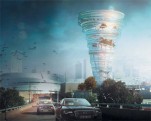Tornado in the City Center

When designing the highrise building the architect ingenuity it is not only in entering the skyscraper in the existing urban environment. Ideally the project should, as much as possible, reflect the spirit of the city, its essence and in the future perhaps become its limelight symbol. Whether the Tulsa Tornado Tower designed for Oklahoma, become such a landmark, only a matter of time.
In Tulsa, the second largest city in the state of Oklahoma, in the framework of the reorganization of the city center has been presented several projects. As a part of the so-called “Reimagining Downtown” assignment, one firm envisioned transforming an old auto supply store on E. 2nd Street into a performing arts hub complete with live/work spaces reserved for local artists. Another firm proposed turning a body shop-turned-indoor parking lot in the nightlife-heavy Blue Dome District into a theme restaurant centered on Tulsa’s history as a former oil hotspot.
The third architecture firm, Kinslow Keith & Todd (KKT), were tasked with (conceptually) breathing new life into a 28,000-square-foot 1920s-era warehouse at 202 S. Guthrie Avenue that is currently used as a parking garage. The redevelopment plan pitched by KKT has managed to garner a huge amount of buzz over the past several days. The proposal has been called tone-deaf, insensitive, potentially iconic, absolutely amazing and a true fate-tempter. Dennis Mersereau of Gawker Media weather sub-blog The Vane immediately declared: “I want to go there.”
The proposal itself calls for a mixeduse high-rise building to be built atop the existing structure, which would serve as the “tower base.” The primary tenant would be the Oklahoma Weather Museum and Research Center, a nonexistent institution that’s not to be confused with the very real National Weather Center in Norman, Oklahoma. And since the 30-story tower, topped off with a revolving restaurant a la Seattle’s Space Needle, would be largely dedicated to the atmospheric sciences, it only makes sense that it take the form of a tornado towering above downtown Tulsa.
From the first glance it looks unbelievable, a twistershaped building in a region smack dab in the middle of Tornado Alley and in a vulnerable city that was devastated by a ferocious storm system that barreled through the area on June 8, 1974. In total, 76 tornadoes have directly hit Tulsa County since 1950. This project is certainly an audacious instance of programmatic architecture, for sure, one designed to be “easily identifiable and locally relevant.”
Full content of this issue you can read here
The full version of the article can be read in our printed issue, also you can subscribe to the web-version of the magazine
 Materials provided by Kinslow Keith & Todd
Materials provided by Kinslow Keith & Todd


